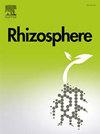Wheat as model to study avocado root rot and interactions with rhizobacteria
IF 3.5
3区 生物学
Q1 PLANT SCIENCES
引用次数: 0
Abstract
Avocado white root rot (AWRR), caused by Rosellinia necatrix, presents significant research challenges due to the practical difficulties and limited availability of using avocado plants as experimental model. To address these limitations, a novel wheat-based model has been developed. This model facilitates the study of rhizospheric interactions between R. necatrix and beneficial bacteria isolated from avocado roots. Wheat seeds were challenged in pots with R. necatrix, which effectively colonizes and infects wheat roots, inducing observable aerial symptoms that enable quantitative assessment of disease severity. Additionally, beneficial bacteria, originally isolated from avocado roots, demonstrate comparable colonization efficiency on wheat roots. The use of fluorescent-tagged microbial strains allowed visualization of the interactions taking place at the wheat root. This wheat model proved effective for evaluating biocontrol agents, yielding consistent results with previous observations in avocado plants. These findings indicate that wheat can be considered an additional tool for investigating AWRR-related rhizospheric dynamics.
以小麦为模型研究牛油果根腐病及其与根瘤菌的相互作用
牛油果白根腐病(AWRR)是由rossellinia necatrix引起的,由于实际应用困难和可用性有限,牛油果植物作为实验模型面临着重大的研究挑战。为了解决这些限制,开发了一种新的基于小麦的模型。该模型有助于研究牛油果根中分离的牛油果芽孢杆菌与有益菌之间的根际相互作用。小麦种子在盆栽中受到黑穗病病菌的侵袭,黑穗病病菌能有效地定殖并感染小麦根系,诱发可观察到的空气症状,从而能够定量评估疾病的严重程度。此外,最初从鳄梨根中分离出来的有益细菌在小麦根上的定殖效率也相当。使用荧光标记的微生物菌株可以可视化小麦根部发生的相互作用。该小麦模型被证明是有效的生物防治剂评估,结果与之前在鳄梨植株上的观察结果一致。这些发现表明小麦可以被认为是研究awrr相关根际动态的额外工具。
本文章由计算机程序翻译,如有差异,请以英文原文为准。
求助全文
约1分钟内获得全文
求助全文
来源期刊

Rhizosphere
Agricultural and Biological Sciences-Agronomy and Crop Science
CiteScore
5.70
自引率
8.10%
发文量
155
审稿时长
29 days
期刊介绍:
Rhizosphere aims to advance the frontier of our understanding of plant-soil interactions. Rhizosphere is a multidisciplinary journal that publishes research on the interactions between plant roots, soil organisms, nutrients, and water. Except carbon fixation by photosynthesis, plants obtain all other elements primarily from soil through roots.
We are beginning to understand how communications at the rhizosphere, with soil organisms and other plant species, affect root exudates and nutrient uptake. This rapidly evolving subject utilizes molecular biology and genomic tools, food web or community structure manipulations, high performance liquid chromatography, isotopic analysis, diverse spectroscopic analytics, tomography and other microscopy, complex statistical and modeling tools.
 求助内容:
求助内容: 应助结果提醒方式:
应助结果提醒方式:


